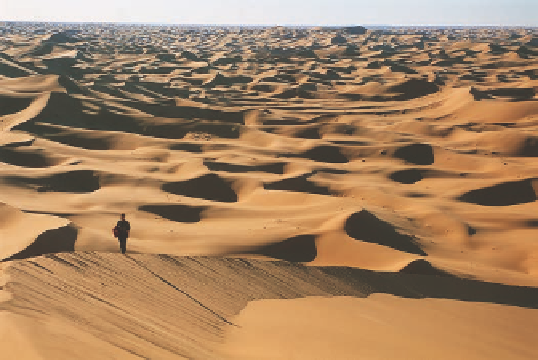Geoscience Reference
In-Depth Information
(a)
(b)
Figure 18.17 Sand seas.
(a) The Sahara Desert is best known for the massive sand dunes present in this very dry environment domi-
nated by the Subtropical High pressure system. (b) The Nebraska Sand Hills is the largest sand sea in the Western Hemisphere and contains
a wide variety of dune forms. Although isolated areas of blowing sand occur in the area, the dunes are mostly stabilized by an extensive
cover of grass. Do you see the similarity in form with the Sahara?
characteristics in most dunes. Overall, the most important fac-
tors that influence the shapes of dunes are wind speed, the
amount of stabilizing vegetation, and the sand supply—that is,
how much sand is present for the wind to move. The amount
and kind of vegetation is a critical variable because plant roots
hold deposits of eolian sand together. If a sand dune is well
vegetated, it tends to remain stable—that is, it stays in one
place—unless it is significantly disturbed through human im-
pact, drought, or a major storm. If such an event occurs, bare
sand can be exposed and the dune becomes active and begins
to move.
On a much more local level, individual dunes can be clas-
sified based on a variety of factors that depend on the complex
interaction of sand supply, the amount of vegetation present,
and wind speed and prevailing direction. The variability of
these interactions results in at least eight major classes of
dunes that can be seen in Figure 18.18. For simplicity, this
discussion will be initially subdivided on the basis of dunes
that develop in landscapes that are poorly vegetated as op-
posed to those where plants are common. Another way to con-
sider this relationship is that dunes in poorly vegetated areas
are “free,” whereas those in vegetated areas are “anchored.”
As you work your way through this classification system, re-
fer to Figure 18.18.
Beginning with free dunes, let's first examine those that
form where sand supply is limited. The first of such dunes to
consider is a
dome dune
, which is an individual mound of sand
that has an oval form (Figure 18.19a) with no slip face. Dome
dunes are temporary features with low relief and are thought
to form because the wind has not blown from one direction
long enough for a slip face to form, or because wind direc-
tion frequently changes. If sufficient time elapses, or winds
become unidirectional, dome dunes can be modified into
barchan dunes
. These dunes look like a crescent from above
and have a gently inclined windward slope with steep lee side,
around which tapering cusps of the dune project downwind
(Figure 18.19b). Usually, barchans are isolated dunes that
form in areas of strong wind and relatively small amounts of
sand. Where winds are weak, however, and massive quantities
of sand are present,
barchanoid ridges
may develop (Figure
18.18). These dunes are sinuous, asymmetrical landforms that
are transitional to yet another kind of dune called a
transverse
ridge
. Transverse ridges are primarily a consequence of unidi-
rectional winds that result in a linear deposit of sand perpen-
dicular to the prevailing wind direction.
Classification of Sand Dunes
and Related Landforms
Although dunes acquire a distinctive cross-sectional shape
through the combined processes of erosion and deposition,
their overall form can vary in a way that promotes classifica-
tion. On a very broad scale, the largest depositional features re-
lated to eolian sand are
sand sheets
and
sand seas
. Sand sheets
are horizontal to semi-horizontal bodies of sand that exhibit
little or no surface topography. In contrast, sand seas are vast
regions where enormous quantities of sand result in a wide va-
riety of dune types. The best-known sand sea is in the Sahara
Desert in Africa (Figure 18.17a). Sand seas occur elsewhere
in the world, however, such as the Namib sand sea in the Na-
mib Desert on the southwest coast of Africa (Figure 18.1). The
largest sand sea in North America is the Nebraska Sand Hills,
which is over 32,000 km
2
(about 12,350 mi
2
) in size. This sand
sea is largely stabilized at the present time due to an extensive
cover of grass (Figure 18.17b). Research indicates, however,
that it has been very active at various times within the Holo-
cene Epoch (the past 10,000 years) when intensive droughts
reduced the vegetation cover.


